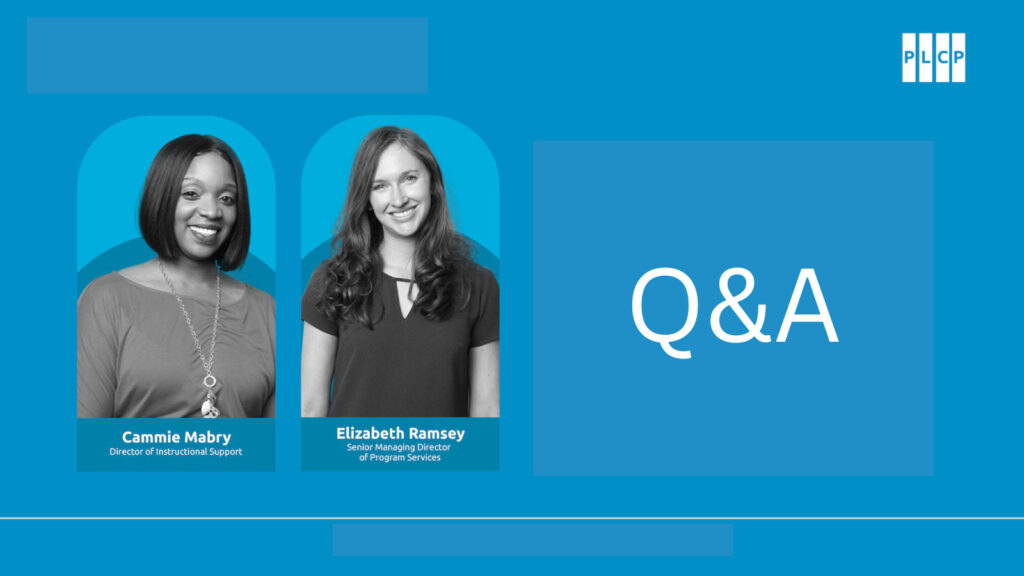
Q&A: Strengthening Professional Learning Structures
During a recent webinar, Elizabeth Ramsey, Senior Managing Director of Program Services, and Cammie Mabry, Director of Instructional Support, answered questions from our audience on a variety of topics related to the Professional Learning Conditions and Practices.
The most relevant questions and answers from the session are compiled below, covering everything from building relationships between leaders and teachers to implementing new PL structures in the midst of HQIM adoption.
This transcript has been edited for brevity and clarity—you can access full webinar recording here.
—
Is it better to put in place one PL condition at a time, or are there some that can be established simultaneously?
CM: Start with vision and time. Especially time for collaborative planning. Once you get that protected time, you can say, “Let’s set a vision and think about the protocols.” Because, of course, there’s no point in having a time and a place with nothing to do. Additionally, I suggest you look at the first five conditions together: vision, time, protocols, roles, and training. I would look at those first together because the other two conditions, investment and affirmation, will begin to improve as you get better at those first five.
Is it appropriate for instructional coaches to lead PLCs?
CM: Yes! Always look for the person who has the content knowledge to be able to drive the work. Then, think about the facilitation—how are you giving them time to prepare to engage in those PLCs? You have to consider: What are our roles and responsibilities as we enter into the space? What are the outcomes we’re trying to achieve? Who is best fit to help us achieve those outcomes?
What are your recommendations for school-day professional learning sessions, keeping in mind that staffing and scheduling is a challenge in many schools right now?
CM: If staffing is a challenge, then there could be some vision and alignment work that we can do to ensure that we’re all clear about what we’re doing and why we’re doing it, because that clarity can help with culture and community.
If I had to choose just one practice during collaboration time due to staffing challenges, it would be unit internalization to cover more material during one meeting. But, you have to think about the context of your school and the needs of your school. Remember to use the teacher surveys—your teachers will tell you what they need.
ER: I love the point about unit internalization, because I do think that’s a good bang for your buck. I also think sometimes we get in our heads that we need a certain amount of time for collaborative planning to be effective, like, “It has to be 90 minutes.” It might be helpful to try to be creative about your time, because I think that we can make it work in the margins a little bit more sometimes. It’s all in what you’re trying to achieve in the time, and having really tight protocols in place. I’ve seen some schools break up one lesson preparation protocol across a couple of 30-minute sessions. Folks find creative workarounds.
CM: I’ve also seen a focus on the highest-leverage moments. Meaning, what is the purpose of the lesson or the aspect of rigor that we’re trying to achieve in this lesson? How are we ensuring that we spend our time making sure the teachers know how to get to that?
“Relationships matter” is such an important takeaway. What are some of the things that leaders can do to support relationships with teachers?
CM: Leaders, most teachers just want you to show up and be in the learning with them. Be the person that they can call on to ask for help. We do a lot of focus groups with teachers, and the one thing that I often hear is, “I just want support. I want to know that my leader understands the work that I’m doing.” They want you to understand the type of work they’re doing so that when they come to you with something, you can understand their experience, more than just giving out directives.
We always say that we are not asking anyone to be an expert—especially if you’re engaging in a new high-quality curriculum, because we are learning things differently than the way we were taught. That’s a very vulnerable moment for us to come in as leaders and say, “I didn’t know this. But we’re learning together. I’m not asking you to be an expert, but I am asking you to be a learner.” If you can model that learner mindset for teachers, they will feel more supported.
How are you defining “leader”? And how does that fit into evaluation?
ER: A leader could be an instructional coach, a principal, an assistant principal, or a teacher leader. There are a lot of different staffing models and approaches here. I’ve seen different approaches for evaluation. Having the same person leading PLCs and performing evaluation can be helpful for efficiency, but it can make the culture more challenging because sometimes people feel less vulnerable in a collaborative space if they know that evaluation is on the table. So, if you have the staffing model to support it, it can be helpful to separate those two functions. A lot of this is just based on the constraints of your system. My key takeaway here is that you can make professional learning structures work as a single site school leader, and you can make them work with a large, distributed instructional leadership team. There are just different trade offs.
Are there any conditions that surprised you, either because they were more or less important than you thought?
CM: I wouldn’t say less important—I would say more overlooked. And that is the roles and responsibilities. We initially left that out as a condition. We quickly realized that a lack of clarity about who was responsible for what was a major gap in schools. It was never that we didn’t think it was important, but we definitely overlooked the importance of it as its own condition.
ER: One that surprised me, because I thought it would carry more weight, is the protocols. There was a chapter where it felt like protocols were the answer. It was helpful to discover all the things that need to go alongside a solid protocol.
CM: I’m so happy you shared that because I think that’s a universal feeling, “If I just had this protocol, it all would work.” What we found is that having clear protocols is amazing. But, if people are not clear about the reason behind the protocol and what you’re trying to achieve, or even the needs of the teachers when using certain protocols, then the protocols will fall flat.
For example, you can clearly state, “This is how we’re going to rehearse lessons. This is how we’re going to do student work analysis.” But if teachers are at a place where they really need time to internalize, then the rehearsal protocol that you have will fall flat.
PL is a space where we want our teachers and our leaders to improve their practice. Having that at the forefront of PL changes the way leaders think about those spaces.
If you’re still in the process of adopting high-quality instructional materials (HQIM), how do you think about building PL structures?
CM: If we do nothing but make sure we have the right PL conditions in place, we’re still in a good place. You can make sure the structure is up and running before HQIM comes into play.
Then, as you begin to implement your HQIM, you can start to think about what protocols that may call for, or what kind of facilitation and what kind of training your people might need.
ER: I love this question because it’s so important to think about how these two levers for instructional improvement interact. HQIM can be such a great way to support teacher practice, but if you have a professional learning system that is totally agnostic to your HQIM, that’s really confusing for teachers. As you’re adopting those materials, consider, “What do I need to change about these two PL structures so that they speak to my curriculum?” And that might be specific protocols, or it might be the type of feedback you give in the classroom.
Continue to think about coherence and alignment as you go through that process. I recommend checking out our free Curriculum Support Guide for more guidance on this—phase 2 of the guide walks through aligning your professional learning to your high-quality instructional materials.


